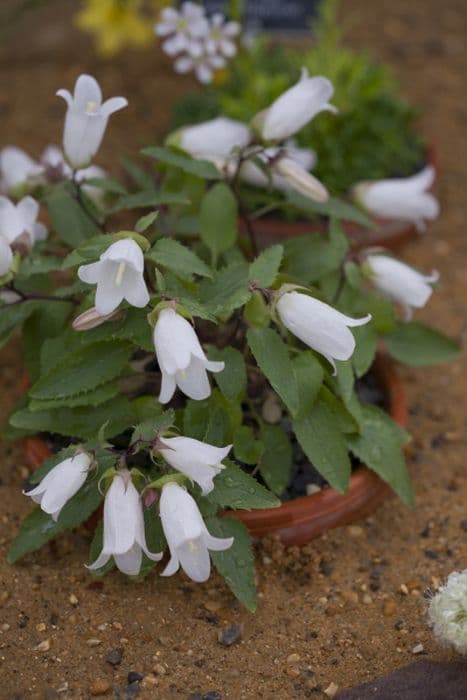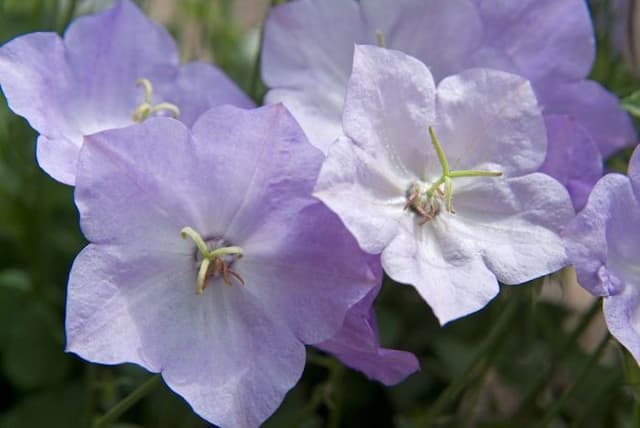Peachleaf Bellflower Campanula persicifolia 'Chettle Charm'

ABOUT
Campanula persicifolia 'Chettle Charm', commonly known as peach-leaved bellflower, is a perennial plant that is appreciated for its ornamental qualities and its bell-shaped flowers. The plant bears a rosette of narrow, lance-shaped, glossy green leaves near its base, and flowering stems emerge from among these leaves. The flowers of 'Chettle Charm' are particularly striking. They are typically cream-colored with a tinge of pale blue at the edges, creating a soft and charming two-tone effect. The blossoms are gracefully arranged along the upright stems, hanging delicately from short stalks in an alternate fashion. Each flower has a bell or cup-like shape with a flared mouth, revealing the inside of the bell that may have faint, darker strokes of color providing subtle contrast and visual depth. The plant has a neat, clump-forming habit, giving it a pleasing structure within garden borders or flower beds. Its blooms appear during the summer months, adding a soft vertical element to the landscape. The charming flowers are not only visually appealing but also attract pollinators like bees and butterflies, adding to the dynamism of the garden environment.
About this plant
 Names
NamesFamily
Campanulaceae
Synonyms
Peach-Leaved Bellflower, Willow Bell, Fairy Bellflower
Common names
Campanula persicifolia 'Chettle Charm'
 Toxicity
ToxicityTo humans
Peach-leaved bellflower is generally considered to be non-toxic to humans. There are no widely recognized reports of poisoning or toxic symptoms associated with the ingestion of this plant. Nevertheless, it is always advisable to exercise caution and avoid consuming parts of ornamental plants without proper knowledge and identification, as individual reactions can vary.
To pets
Peach-leaved bellflower is also generally considered to be non-toxic to pets such as cats and dogs. There is no substantial evidence to suggest that ingestion of this plant causes poisoning in pets. However, as with any non-food plant material, consumption in large amounts might potentially cause mild gastrointestinal upset due to the unusual material in the digestive tract. Always monitor your pets and prevent them from consuming large amounts of any ornamental plants.
 Characteristics
CharacteristicsLife cycle
Perennials
Foliage type
Deciduous
Color of leaves
Green
Flower color
White
Height
2-3 feet (60-90 cm)
Spread
1-2 feet (30-60 cm)
Plant type
Herb
Hardiness zones
3-8
Native area
Europe
Benefits
 General Benefits
General Benefits```html
- Attracts Wildlife: Campanula persicifolia 'Chettle Charm' can attract bees, butterflies, and other beneficial insects, which can help pollinate your garden.
- Aesthetic Appeal: With its beautiful bell-shaped flowers, this plant adds visual interest and beauty to garden beds, borders, and containers.
- Easy to Grow: Peach-leaved bellflower is known for being hardy and relatively easy to care for, needing only basic maintenance to thrive.
- Long Flowering Period: It blooms from late spring to early summer, providing a lengthy display of flowers.
- Drought Tolerance: Once established, it has good drought resistance, making it suitable for regions with low rainfall.
- Versatile: It can be used in a variety of garden styles, including cottage gardens, rock gardens, and perennial borders.
- Cutting Garden: The flowers are suitable for cutting and can be used in floral arrangements.
- Mix and Match: Its height and form can be easily mixed with other perennial plants to create a diverse and layered garden design.
- Non-Invasive: Unlike some other garden plants, it doesn't typically spread uncontrollably, making it an ideal choice for keeping a tidy garden.
- Seasonal Interest: Its foliage provides a green backdrop early in the season, with blooms adding color in the summer.
 Medical Properties
Medical PropertiesThis plant is not used for medical purposes.
 Air-purifying Qualities
Air-purifying QualitiesThis plant is not specifically known for air purifying qualities.
 Other Uses
Other Uses- Photography Subject: The peach-leaved bellflower 'Chettle Charm' with its distinctive white flowers edged with blue can serve as an exquisite subject for macro photography projects.
- Art Inspiration: Artists may draw inspiration from the unique pattern and colors of 'Chettle Charm' for paintings, illustrations, and textile designs.
- Fairy Gardens: Due to its delicate appearance, it can be included in fairy gardens to create a whimsical feel.
- Wedding Decor: 'Chettle Charm' can be incorporated into wedding bouquets or centerpieces for a rustic or 'something blue' theme.
- Educational Tool: This plant can be used to teach botany students about plant morphology and reproductive systems in angiosperms.
- Pressing and Craft: The flowers are suitable for pressing and can be used in craft projects like handmade greeting cards or bookmarks.
- Ikebana: 'Chettle Charm' can be used in the Japanese art of flower arranging, where its tall stems and graceful flowers fit the aesthetic requirements.
- Companion Planting: Gardeners may use it for companion planting in rose beds to create visually appealing combinations and distract pests.
- Ephemeral Tattoos: The image of 'Chettle Charm' can be used in temporary tattoos for botanical-themed events or personal use.
- Dye Source: Though not commonly known for this, petals of 'Chettle Charm' could potentially be used to create natural dyes for small-scale or artisanal fabric dyeing.
Interesting Facts
 Feng Shui
Feng ShuiPeach-leaved bellflower is not used in Feng Shui practice.
 Zodiac Sign Compitability
Zodiac Sign CompitabilityPeach-leaved bellflower is not used in astrology practice.
 Plant Symbolism
Plant Symbolism- Gratitude - Campanula, commonly known as bellflower, often symbolizes gratitude due to its bell shape, as if it's ringing to say thank you.
- Constancy and Perseverance - The bellflower's ability to grow in a variety of conditions reflects the qualities of constancy and perseverance in the face of challenges.
- Hope and Affection - Its delicate and appealing blooms are often associated with feelings of hope and affection, as it brings beauty to the garden even in tough soils.
- Unwavering Love - The bellflower is also a symbol of undying love and faithfulness, with its persistence and enduring presence.
 Water
WaterPeach-leaved bellflower should be watered regularly, particularly during its blooming period and dry spells. The soil should be kept moist but not waterlogged, as good drainage is essential. You can water the plant deeply once or twice a week, depending on the climate and soil conditions, ensuring the equivalent of 1 inch of rainfall. Overhead watering should be avoided to prevent leaf spot diseases; instead, water at the base of the plant. In hot summer months, you might need to increase watering frequency; and during the winter, reduce it as the plant requires less moisture.
 Light
LightPeach-leaved bellflower thrives in full sun to partial shade. The ideal spot for this plant is one where it can receive morning sunlight and afternoon shade, especially in hotter climates. Ensure that it gets at least 6 hours of sunlight daily for optimal flowering. Avoid placing it in deep shade, as this will reduce blooming and may cause the plant to become leggy.
 Temperature
TemperaturePeach-leaved bellflower prefers moderate temperatures and can tolerate a range from 50 to 85 degrees Fahrenheit. It is hardy in USDA zones 3 through 8, meaning it can survive winters with temperatures as low as -30 to -40 degrees Fahrenheit. While the plant enjoys warmth during the growing season, it can also endure a light frost.
 Pruning
PruningPruning peach-leaved bellflower is essential to maintain its shape, encourage more blooms, and prevent self-seeding if not desired. Deadheading, or removing spent flowers, should be done consistently throughout the blooming season to encourage more flowers. After the main blooming period, cut back the flower stems to basal foliage to tidy the plant and stimulate a second flush of blooms. Pruning is best done immediately after the first flowering cycle is complete.
 Cleaning
CleaningAs needed
 Soil
SoilThe Peach-leaved Bellflower prefers a well-draining soil mix rich in organic matter with neutral to alkaline pH, generally around 7.0 to 8.0. A mixture of loam, compost, and sand or perlite would provide appropriate conditions for healthy growth. The inclusion of some calcium carbonate can help maintain the alkalinity of the soil if necessary.
 Repotting
RepottingPeach-leaved Bellflower is typically grown as a perennial garden plant and does not require frequent repotting. In a pot or container, repot it every 2-3 years or when it outgrows its current pot, using a fresh soil mix as indicated above.
 Humidity & Misting
Humidity & MistingPeach-leaved Bellflower tolerates a wide range of humidity levels and will do well in the average ambient moisture found in most garden environments. They do not require any special humidity considerations as long as they are planted in well-draining soil and have adequate air circulation.
 Suitable locations
Suitable locationsIndoor
Ensure bright light, good airflow, and moderate watering.
Outdoor
Plant in partial shade, provide well-draining soil, and water regularly.
Hardiness zone
3-8 USDA
 Life cycle
Life cyclePeach-leaved bellflower 'Chettle Charm', begins its life cycle as a seed, usually requiring a period of cold stratification to break dormancy. Upon germination, it develops into a seedling, then forms a rosette of basal leaves in its first year. In its second year, the plant sends up flowering stalks, blooms in early to midsummer with white flowers tinged with blue, and may rebloom if deadheaded. After pollination, typically by bees, the flowers produce seed capsules containing numerous seeds that disperse for the next generation. This perennial plant may then enter a period of dormancy in the winter months, dying back to the ground before regrowing from its rootstock in spring. Throughout its life, the plant forms a clumping habit, slowly expanding in size each year.
 Propogation
PropogationPropogation time
Spring-Early Summer
The Campanula persicifolia 'Chettle Charm', commonly referred to as Peach-leaved Bellflower, is most popularly propagated by division. This technique is typically carried out in the early spring or after the flowering season has finished in late summer to early fall. By dividing, gardeners can ensure the health of the plant by not interrupting its growth during its blooming period. To propagate by division, one would carefully dig up the plant, making sure to keep a good amount of soil around the roots, and gently separate the plant into smaller sections, each with roots and shoots. The divisions are then replanted into prepared soil, ideally enriched with compost, at the same depth they were growing before, and watered thoroughly. This method quickly produces flowering plants identical to the parent and helps to rejuvenate older clumps that may have become woody or less vigorous.









